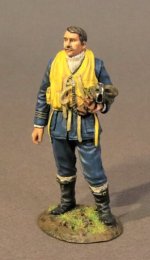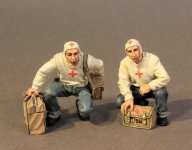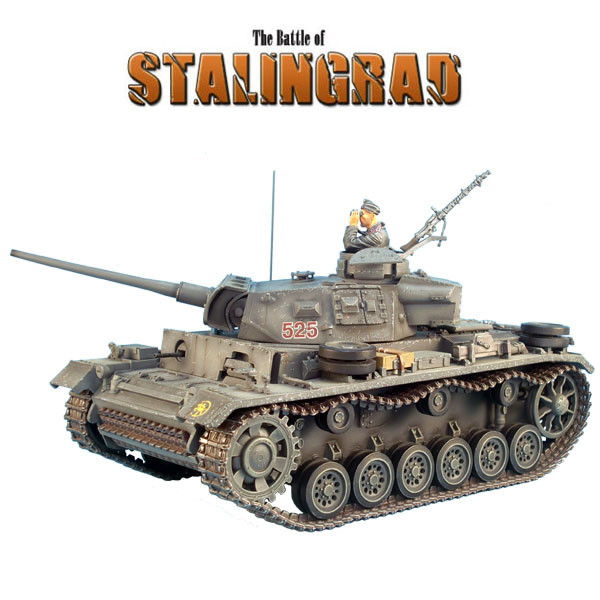NEW RELEASES FOR FEBRUARY 2019
THE SECOND WORLD WAR
The iconic Sturmgeschütz III (Assault Gun) was conceived by none other than Field Marshal Erich von Manstein. Created by mating an armored casemate to a Panzer III chassis, the StuG III was intended to support infantry forces with direct fire. Originally armed with a short barrel, low velocity 75mm cannon, it served admirably in this role. However, following German encounters with the heavily armored Russian T-34, KV-1 and KV-2, in 1942 the StuG III was modified to mount the powerful long barreled, high velocity 75mm StuK40/L48 cannon. With this heavier armament, the StuG III shifted roles to that of a tank destroyer, where its powerful cannon, heavy armor, and low silhouette made it a deadly opponent for Allied armor.
The most prolific model StuG was the Ausf G, with 7,720 produced from December 1942 until March 1945. It remained in service due to it's reliability, excellent combat performance, and inexpensive cost. In 1944, a StuG III cost 82,500 Rechsmarks to produce. In contrast, the Panther cost 117,100 Reichsmarks and a Tiger 250,800 Reichmarks. The StuG III served on all fronts, and even after the introduction of more advanced tanks by the Allies, the StuG III's 75mm cannon and 80mm of armor protection still proved a deadly combination, especially when used in ambush positions. By wars end, thousands of Allied tanks fell victim to the StuG III.
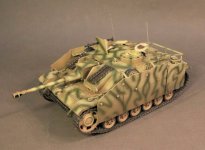
GA-20
THE SECOND WORLD WAR,
GERMAN ARMOUR,
GROSSDEUTSCHLAND STUG III Ausf. G.
BATTLE OF KURSK, 1943.
(16pcs)
The GA-20 model represents a StuG III Ausf G produced by Alkett in early 1943 and employed by Panzergrenadier Division "Grossdeutschland" at the Battle of Kursk. Grossdeutschland was the German Heer's elite formation and from the beginning of Operation Barbarossa it fought exclusively on the Eastern Front against the Russians. Lavishly equipped, at Kursk Grossdeutschland possessed a full Sturmgeschütz Abteilung in addition to its Panther Brigade and a company of the legendary Tiger tanks. Sturmgeschütz Abteilung "GD" fought admirably at Kursk (arguably better than the division's Panzer units) where it was ably led by Knight's Cross winner Hauptman Peter Frantz.
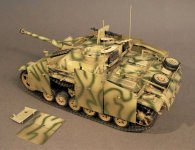
The Grossdeutschland StuG III Ausf G features a two-color camo pattern of Dunkelgelb and Olivgrun common at Kursk, individually removable schürzen side armor panels (meant to protect the StuG from Soviet anti-tank rifles), opening loaders hatch, and two machine-gun mounts.
Additionally, it has common modifications StuG Abteilung "GD" made to their vehicles, including extra track links mounted on the front as additional armor, extra road wheels that can be mounted on the sides of the StuG, and a stowage rail on the rear engine deck
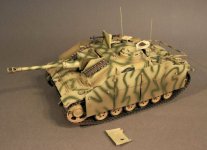
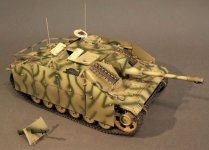
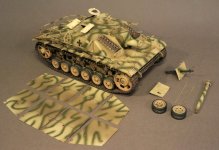
THE SECOND WORLD WAR
The iconic Sturmgeschütz III (Assault Gun) was conceived by none other than Field Marshal Erich von Manstein. Created by mating an armored casemate to a Panzer III chassis, the StuG III was intended to support infantry forces with direct fire. Originally armed with a short barrel, low velocity 75mm cannon, it served admirably in this role. However, following German encounters with the heavily armored Russian T-34, KV-1 and KV-2, in 1942 the StuG III was modified to mount the powerful long barreled, high velocity 75mm StuK40/L48 cannon. With this heavier armament, the StuG III shifted roles to that of a tank destroyer, where its powerful cannon, heavy armor, and low silhouette made it a deadly opponent for Allied armor.
The most prolific model StuG was the Ausf G, with 7,720 produced from December 1942 until March 1945. It remained in service due to it's reliability, excellent combat performance, and inexpensive cost. In 1944, a StuG III cost 82,500 Rechsmarks to produce. In contrast, the Panther cost 117,100 Reichsmarks and a Tiger 250,800 Reichmarks. The StuG III served on all fronts, and even after the introduction of more advanced tanks by the Allies, the StuG III's 75mm cannon and 80mm of armor protection still proved a deadly combination, especially when used in ambush positions. By wars end, thousands of Allied tanks fell victim to the StuG III.

GA-20
THE SECOND WORLD WAR,
GERMAN ARMOUR,
GROSSDEUTSCHLAND STUG III Ausf. G.
BATTLE OF KURSK, 1943.
(16pcs)
The GA-20 model represents a StuG III Ausf G produced by Alkett in early 1943 and employed by Panzergrenadier Division "Grossdeutschland" at the Battle of Kursk. Grossdeutschland was the German Heer's elite formation and from the beginning of Operation Barbarossa it fought exclusively on the Eastern Front against the Russians. Lavishly equipped, at Kursk Grossdeutschland possessed a full Sturmgeschütz Abteilung in addition to its Panther Brigade and a company of the legendary Tiger tanks. Sturmgeschütz Abteilung "GD" fought admirably at Kursk (arguably better than the division's Panzer units) where it was ably led by Knight's Cross winner Hauptman Peter Frantz.

The Grossdeutschland StuG III Ausf G features a two-color camo pattern of Dunkelgelb and Olivgrun common at Kursk, individually removable schürzen side armor panels (meant to protect the StuG from Soviet anti-tank rifles), opening loaders hatch, and two machine-gun mounts.
Additionally, it has common modifications StuG Abteilung "GD" made to their vehicles, including extra track links mounted on the front as additional armor, extra road wheels that can be mounted on the sides of the StuG, and a stowage rail on the rear engine deck





